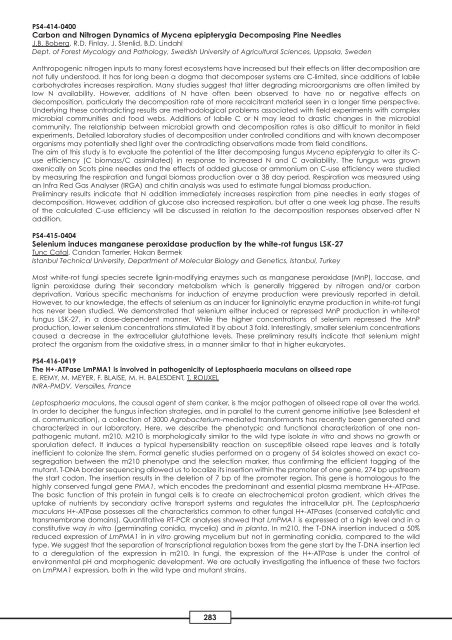Handbook Part 2 - International Mycological Association
Handbook Part 2 - International Mycological Association
Handbook Part 2 - International Mycological Association
You also want an ePaper? Increase the reach of your titles
YUMPU automatically turns print PDFs into web optimized ePapers that Google loves.
PS4-414-0400<br />
Carbon and Nitrogen Dynamics of Mycena epipterygia Decomposing Pine Needles<br />
J.B. Boberg, R.D. Finlay, J. Stenlid, B.D. Lindahl<br />
Dept. of Forest Mycology and Pathology, Swedish University of Agricultural Sciences, Uppsala, Sweden<br />
Anthropogenic nitrogen inputs to many forest ecosystems have increased but their effects on litter decomposition are<br />
not fully understood. It has for long been a dogma that decomposer systems are C-limited, since additions of labile<br />
carbohydrates increases respiration. Many studies suggest that litter degrading microorganisms are often limited by<br />
low N availability. However, additions of N have often been observed to have no or negative effects on<br />
decomposition, particularly the decomposition rate of more recalcitrant material seen in a longer time perspective.<br />
Underlying these contradicting results are methodological problems associated with field experiments with complex<br />
microbial communities and food webs. Additions of labile C or N may lead to drastic changes in the microbial<br />
community. The relationship between microbial growth and decomposition rates is also difficult to monitor in field<br />
experiments. Detailed laboratory studies of decomposition under controlled conditions and with known decomposer<br />
organisms may potentially shed light over the contradicting observations made from field conditions.<br />
The aim of this study is to evaluate the potential of the litter decomposing fungus Mycena epipterygia to alter its C-<br />
use efficiency (C biomass/C assimilated) in response to increased N and C availability. The fungus was grown<br />
axenically on Scots pine needles and the effects of added glucose or ammonium on C-use efficiency were studied<br />
by measuring the respiration and fungal biomass production over a 38 day period. Respiration was measured using<br />
an Infra Red Gas Analyser (IRGA) and chitin analysis was used to estimate fungal biomass production.<br />
Preliminary results indicate that N addition immediately increases respiration from pine needles in early stages of<br />
decomposition. However, addition of glucose also increased respiration, but after a one week lag phase. The results<br />
of the calculated C-use efficiency will be discussed in relation to the decomposition responses observed after N<br />
addition.<br />
PS4-415-0404<br />
Selenium induces manganese peroxidase production by the white-rot fungus LSK-27<br />
Tunc Catal, Candan Tamerler, Hakan Bermek<br />
Istanbul Technical University, Department of Molecular Biology and Genetics, Istanbul, Turkey<br />
Most white-rot fungi species secrete lignin-modifying enzymes such as manganese peroxidase (MnP), laccase, and<br />
lignin peroxidase during their secondary metabolism which is generally triggered by nitrogen and/or carbon<br />
deprivation. Various specific mechanisms for induction of enzyme production were previously reported in detail.<br />
However, to our knowledge, the effects of selenium as an inducer for ligninolytic enzyme production in white-rot fungi<br />
has never been studied. We demonstrated that selenium either induced or repressed MnP production in white-rot<br />
fungus LSK-27, in a dose-dependent manner. While the higher concentrations of selenium repressed the MnP<br />
production, lower selenium concentrations stimulated it by about 3 fold. Interestingly, smaller selenium concentrations<br />
caused a decrease in the extracellular glutathione levels. These preliminary results indicate that selenium might<br />
protect the organism from the oxidative stress, in a manner similar to that in higher eukaryotes.<br />
PS4-416-0419<br />
The H+-ATPase LmPMA1 is involved in pathogenicity of Leptosphaeria maculans on oilseed rape<br />
E. REMY, M. MEYER, F. BLAISE, M. H. BALESDENT, T. ROUXEL<br />
INRA-PMDV, Versailles, France<br />
Leptosphaeria maculans, the causal agent of stem canker, is the major pathogen of oilseed rape all over the world.<br />
In order to decipher the fungus infection strategies, and in parallel to the current genome initiative (see Balesdent et<br />
al. communication), a collection of 3000 Agrobacterium-mediated transformants has recently been generated and<br />
characterized in our laboratory. Here, we describe the phenotypic and functional characterization of one nonpathogenic<br />
mutant, m210. M210 is morphologically similar to the wild type isolate in vitro and shows no growth or<br />
sporulation defect. It induces a typical hypersensibility reaction on susceptible oilseed rape leaves and is totally<br />
inefficient to colonize the stem. Formal genetic studies performed on a progeny of 54 isolates showed an exact cosegregation<br />
between the m210 phenotype and the selection marker, thus confirming the efficient tagging of the<br />
mutant. T-DNA border sequencing allowed us to localize its insertion within the promoter of one gene, 274 bp upstream<br />
the start codon. The insertion results in the deletion of 7 bp of the promoter region. This gene is homologous to the<br />
highly conserved fungal gene PMA1, which encodes the predominant and essential plasma membrane H+-ATPase.<br />
The basic function of this protein in fungal cells is to create an electrochemical proton gradient, which drives the<br />
uptake of nutrients by secondary active transport systems and regulates the intracellular pH. The Leptosphaeria<br />
maculans H+-ATPase possesses all the characteristics common to other fungal H+-ATPases (conserved catalytic and<br />
transmembrane domains). Quantitative RT-PCR analyses showed that LmPMA1 is expressed at a high level and in a<br />
constitutive way in vitro (germinating conidia, mycelia) and in planta. In m210, the T-DNA insertion induced a 50%<br />
reduced expression of LmPMA1 in in vitro growing mycelium but not in germinating conidia, compared to the wild<br />
type. We suggest that the separation of transcriptional regulation boxes from the gene start by the T-DNA insertion led<br />
to a deregulation of the expression in m210. In fungi, the expression of the H+-ATPase is under the control of<br />
environmental pH and morphogenic development. We are actually investigating the influence of these two factors<br />
on LmPMA1 expression, both in the wild type and mutant strains.<br />
283









